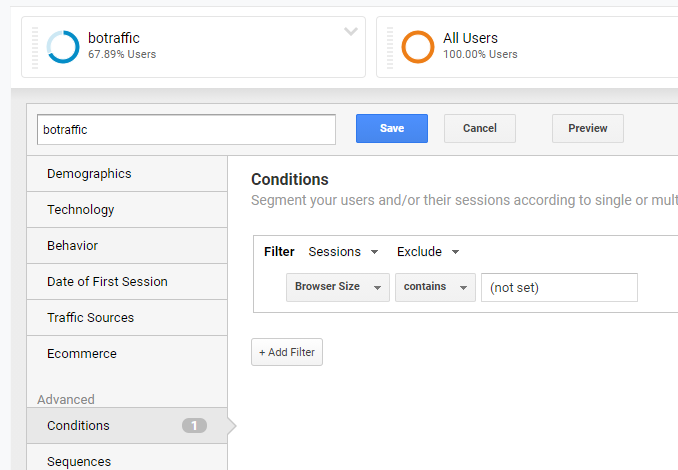


- #GOOGLE ANALYTICS TRAFFICBOT HOW TO#
- #GOOGLE ANALYTICS TRAFFICBOT CODE#
- #GOOGLE ANALYTICS TRAFFICBOT FREE#
Once the table below has updated, head to the top of the page and select the ‘Add Segment’ option: Head to the top of you page and select the ‘Source’ report underneath the ‘Secondary Dimension’ drop down option: To filter out traffic like this from your GA, you’ll need to head to: Acquisition > All Traffic > Channels

#GOOGLE ANALYTICS TRAFFICBOT HOW TO#
How to Filter It Out From Your Google Analytics Reports Session Duration and if the time spent on your site is a matter of seconds, then it’s extra confirmation that you have spam traffic coming to you site because the site recorded a visit but no one actually visited. xyz then it’s most likely to be spam traffic.Ĭheck the Avg. If you see any links that you don’t recognise, or if they have “bot” or “free” in the URL name or end with a TLD you don’t recognise like. If you see something like this, then head to the Acquisition > All Traffic > Source/Medium report from with your Google Analytics admin and review the list of the source/medium traffic results.

If there are any spikes in the graph, this could be spam (or you were just really popular that day!) You should be checking your Google Analytics account on a regular basis and looking at the traffic graph over a set period of time on a monthly, if not weekly basis. How to Spot Referral Spam Dataįirst thing’s first – you actually have to find that you have a problem with bot traffic. So that’s what this post is all about: showing you how to filter out traffic from certain views in your Google Analytics reports. I realised that although i had told them WHAT is is I could have shown them how to filter that traffic out from their reports so that they could get a better picture of the true behavior of visitors on their site. More often than not it’s a online store that has affiliate links to Amazon or Ebay products. The reason you get referral spam? Most likely so that you investigate the site link you can see the traffic coming from.
#GOOGLE ANALYTICS TRAFFICBOT CODE#
If for any reason you messed up, you have your Raw / Unfiltered view which you can reference.It’s called referrer spam and sometimes it doesn’t’ even visit your site (which is why you may see 0:00 seconds of time spent on your site), instead triggering the analytics tracking code to fire and record the visit. Once you’ve done this, the filter is saved and any future data from spam bots will be ignored in this view. Here’s what it should look like when it’s complete. I’ve seen others use these exact same filters and they don’t verify.
#GOOGLE ANALYTICS TRAFFICBOT FREE#
Feel free to verify the filter if you wish. But if you look at the event globally you can find these four directories. /trafficbot.live|/trafficbot.life|/bot-traffic.icu|/bot-traffic.xyz – you may only see one or two of these in your analytics.Exclude | traffic to the subdirectories | That are equal to.I would avoid names like “bot spam” since a few years from now there might be new type of bot spam. Give the filter a descriptive name like “2021Q1BotSpam”.We’re going to do all of the work today in your non-unfiltered view – in my case I call that the Master view. And a few types of spam I’ve seen in previous years.On my Master view with my filters – I remove prevent a whole bunch of data from coming in: The unfiltered view, my master view, and a test view for experimentation. Knowing you have an unfiltered view then it’s time to create one or more views that removes any unimportant data. This will be your backup view that collects all data. One of them is that you can create an Unfiltered view. There’s several great things about views. Each view gets the exact same data but you can filter out different pieces of that data. One of the best features of Google Analytics is that you can setup multiple views. This could throw off your entire analytics & reporting system, so let’s see if we can prevent this type of spam moving forward. It was added by several thousand bots coming from different IP addresses. The first thing to know is that this is spam. If you’re the type of person who checks your website Google Analytics often you might have noticed a spike in traffic at the end of January or early February.


 0 kommentar(er)
0 kommentar(er)
